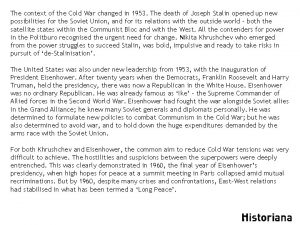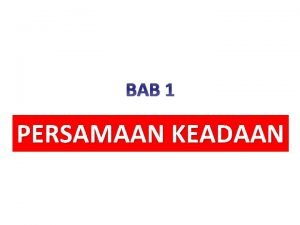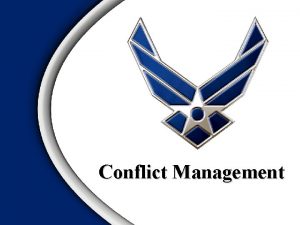Sources of conflict Helen Peng 01 Contents Sources



















- Slides: 19

Sources of conflict Helen Peng

01 Contents Sources of Conflict Personal Factors Causes of Conflict Stages in conflict Structural Factors

SOURCES OF CONFLICT

SOURCES OF CONFLICT

SOURCES OF CONFLICT Conflict can always be traced to a source, the most common of which are: 1. Misunderstanding and Miscommunication 2. Dishonesty 3. Negligence 4. Intention 5. Exclusive investment in one’s opinions and belief system 6. Failure to establish boundaries 7. Mishandling of conflict 8. Fear 9. Hidden agendas

SOURCES OF CONFLICT • Relationship within and among groups may be a source of conflict. Some people/groups have tendency to dominate. Others are comfortable with dependence and hierarchical relationship. • Similarly some people prefer to relate on equality basis and feel uncomfortable in hierarchical relationship. • Better way for dealing with situation is to see the relationship in terms of interdependence. (A depends on B for fulfilling certain needs, similarly B depends on A for some other things. ) • Such relationship develops appreciation for mutual needs and resultant orientation is empathy and cooperation. **If conflicts are to be resolved, people need to take initiatives and risks.

CAUSES OF CONFLICT p Communicational Aspect of Conflict: Too much or too little communication …due to differences in background, training, selection perception and inadequate information, etc. p Behavioral Aspect of Conflict: Values, perception, personal biases, viewpoints, etc. p Structural Aspect of Conflict: These conflict due to the structural design of the organizations…. role ambiguity , etc.

STRUCTURAL FACTORS The causes of conflict related to the organization’s structure include: Ø Specialization: A classic conflict of specialization is one between salespeople and engineers. Ø Interdependence: Work that is interdependent requires groups or individuals to depend on one another to accomplish. Ø Common resources: When multiple parties share resources, there is potential for conflict. Ø Goal differences: When work groups have different goals, these goals may be incompatible. Ø Authority relationship: As organizations move towards the team approach and empowerment, there should be less potential for conflict from authority relationships. Ø Status inconsistencies: Having a strong status difference between management and non-management may result in resentment and conflict. Ø Jurisdictional ambiguities: Conflicts emerge over responsibility for the problem.

STRUCTURAL FACTORS


PERSONAL FACTORS • Skill and abilities • Personality • Perceptions • Values and ethics • Emotion • Cultural differences : Experienced, competent workers difficult to work along side new and unskilled recruits : One personality trait that many people find difficult to deal with is abrasiveness : If manager and workers do not have shared perception, for instance of what motivates people : Differences in values and ethics also cause disagreement : The moods of others can be a source of conflict in the workplace misunderstanding : Diversity training that emphasizes education on cultural difference can prevent



STAGES IN CONFLICT • Origins of Conflict: The genesis of conflict lies in human behavior itself. Human action is the output of two major processes-perception and judgment. • There are three sources which are common basis for conflict in organizations: 1. Lateral Differences: Conflict at this level is horizontal among departments, group or persons having generally equal power, influence or status. It is often task related, etc. 2. Hierarchical Difference: Conflict at this level among people wit distinctly and structurally unequal power. 3. Cultural Differences: Unique perspectives and experiences in the external environment, value system and biases prevalent in the larger society; or historical prejudices, attitudes and orientations can produce misunderstanding and antagonism within organizations.

STAGES IN CONFLICT Another way of looking at sources of conflict in a group or an organization, other than plain misunderstanding among individuals, can be situations: 1. 2. 3. 4. 5. 6. 7. 8. Competing for Limited Resources Differentiated Goals Task Interdependence Differences in Perception Organizational Ambiguities Introduction of Change Nature of Communicating Temperaments of People

STAGE OF CONFLICT IMPACT DECISION MAKING

CONTINUUM OF LEADERSHIP BEHAVIOR

NOT AFRAID OF CONFLICT LEARNING HOW TO DEAL WITH

FIRST DEAL WITH EMOTION THEN MANAGE CONFLICT • People first • Things second
 Helen peng age
Helen peng age Helen peng
Helen peng Helen midtown computer solutions helen speaking
Helen midtown computer solutions helen speaking Midtown computer solutions helen speaking
Midtown computer solutions helen speaking Contents of a dead man's pocket conflict
Contents of a dead man's pocket conflict Contents of a dead mans pocket
Contents of a dead mans pocket Changnan peng
Changnan peng Peng duhai
Peng duhai Li you and wang peng
Li you and wang peng Peng
Peng Peng robinson equation of state
Peng robinson equation of state Chunyi peng
Chunyi peng Peng
Peng Wong peng yuen v senanayake
Wong peng yuen v senanayake K
K Peng
Peng Persamaan kondisi
Persamaan kondisi Elise brown oakland university
Elise brown oakland university Bo peng kaggle
Bo peng kaggle Mindy peng
Mindy peng



































